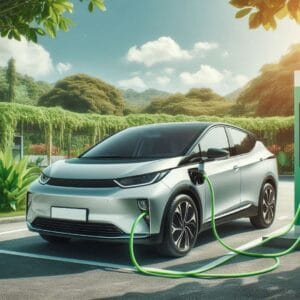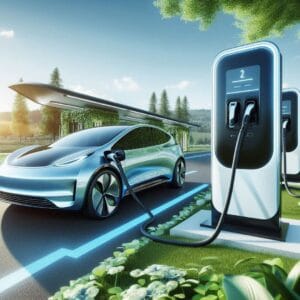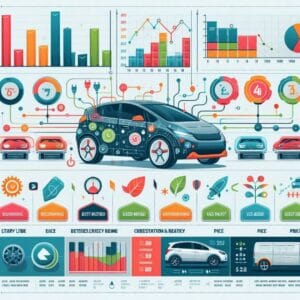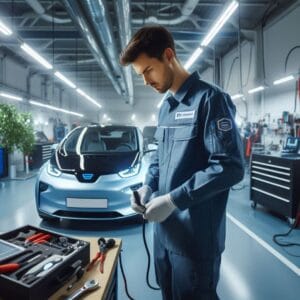Buying a Used Electric Car – Is It Good or Bad?
Buying a used electric car has become one of the most debated topics among modern car buyers. As electric vehicles (EVs) become more mainstream, many people are considering whether it makes sense to buy a second-hand EV instead of a brand-new one. On one side, used EVs are eco-friendly, cheaper, and low-maintenance. On the other side, concerns like battery health, range loss, charging access, and warranty limits make buyers cautious.
In today’s world — where sustainability, fuel savings, and technology play a major role — used electric cars offer a promising option. But they also come with unique challenges unlike traditional petrol vehicles. The biggest question remains:
👉 Is buying a used electric car a smart decision or a risky one?
This article explores both sides in detail and gives you a complete 360° view. We’ll talk about battery degradation, charging infrastructure, EV warranties, maintenance records, physical inspection, and professional evaluation, while also including SEO semantic terms such as:
- EV battery life
- State of Health (SOH)
- USED EV purchase guide
- electric car depreciation
- charging compatibility
- NLP synonyms: pre-owned EV, second-hand electric car, used battery electric vehicle
By the end, you’ll have a clear answer about whether a used EV is good or bad for YOU — not just in general.
Understanding the Rising Popularity of Used Electric Cars

The used EV market has grown dramatically in the last five years. This shift isn’t just about affordability — it’s a global trend. More drivers recognize the environmental benefits, lower running costs, and minimal maintenance needs of electric cars.
Governments worldwide are pushing EV adoption through incentives, tax rebates, and fuel economy standards. As more people buy new EVs, older ones enter the used market, creating a cycle that benefits budget-conscious buyers.
Key Reasons for This Boom
- Lower costs thanks to heavy depreciation of new EVs
- More availability as early EV owners upgrade to newer models
- Improved charging networks in most countries
- Growing trust in EV technology
- Rising fuel prices making EVs more attractive
Additionally, high search volumes for keywords like “best used electric car,” “EV battery life,” “should I buy used EV” show that people are actively researching before making a decision.
Global EV Adoption Trends
Countries like China, the U.S., Norway, Germany, India, and the UAE are rapidly expanding EV infrastructure. According to global mobility data, EV sales have grown more than 300% in the last decade.
Key highlights include:
- Europe leads in charging infrastructure density.
- China leads in battery manufacturing and affordable EV models.
- UAE is expanding charging stations across Dubai and Abu Dhabi.
- USA is seeing strong growth in Tesla and Ford EV sales.
This global expansion directly boosts the used EV market, giving more affordable buying options.
Why Used EV Demand Is Increasing ?
The biggest reason: Used EVs are significantly cheaper.
A new electric vehicle depreciates 30–40% in the first year alone — much higher than petrol cars. This creates a perfect opportunity for buyers who want modern technology at a fraction of the cost.
Other factors include:
- Low running costs (Zero petrol, cheaper maintenance)
- Clean energy appeal
- Availability of models under warranty
- Better battery tech in newer EVs, making older ones still valuable
People also realize that most EVs have fewer mechanical parts, reducing chances of breakdown.
Pros of Buying a Used Electric Car

Buying a used electric car has many clear advantages that make it an attractive option for budget-conscious or first-time EV buyers.
Some major benefits include:
- Affordable pricing
- Lower total cost of ownership
- Eco-friendly transportation
- Reduced depreciation loss
- Less mechanical wear
Let’s explore the biggest advantages in detail.
Lower Upfront Cost
Electric vehicles are generally more expensive than petrol cars when bought new. However, used EVs become extremely affordable due to high depreciation rates. A brand-new EV priced at $40,000 might sell for $20,000 or less after a couple of years.
Reasons for this price drop include:
- Rapid advancements in battery technology
- Automakers releasing newer models frequently
- Consumer concerns about battery aging
- Previous government incentives lowering initial ownership cost
For many, this creates a golden opportunity — you get advanced features like digital dashboards, regenerative braking, fast charging, and smart connectivity at a much lower price.
Cons of Buying a Used Electric Car
While used EVs have many advantages, they also come with risks that buyers must understand before making a decision.
Battery Degradation Concerns
The biggest drawback of buying a used electric car is battery health. Over time, all EV batteries slowly lose capacity — meaning reduced driving range.
Key causes include:
- Frequent fast-charging
- Extreme heat or cold
- High mileage
- Poor battery management by previous owner
If the battery has degraded heavily (e.g., below 80% SOH), the car may have 30–50% shorter range.
This is why a battery health check is the most important step in evaluating a used EV.
Battery Health – The #1 Deciding Factor

When buying a used electric car, the single most important factor that determines whether the purchase is good or bad is battery health. Unlike petrol vehicles where engine wear is the biggest concern, EVs rely entirely on the condition of their lithium-ion battery pack. If the battery is strong, the car performs well for years. If the battery is weak, the car loses range, charging slows down, and replacement becomes expensive.
Most electric cars lose 1–3% battery capacity per year, depending on usage, climate, and charging habits. Some brands like Tesla (NMC chemistry) degrade slowly, while early Nissan Leaf (no thermal management) models degrade faster. This is why evaluating the State of Health (SOH) report is essential.
To understand battery technology deeply, users can also read your internal article on battery care here: ELECTRIC CAR BATTERY HEALTH
Battery degradation directly affects:
- Range (how far you can drive on one charge)
- Resale value
- Charging speed
- Long-term usability
For scientific references, readers can explore external resources such as:
🌍 U.S. Department of Energy – Battery Basics (energy.gov)
🌍 Global EV Database – Battery statistics (ev-database.org)
A used EV with strong battery health is a great buy. One with degraded battery is a bad investment. That’s why checking battery condition is the top priority.
Why EV Battery Condition Matters Most
The battery pack is the heart of an electric vehicle. It is also the most expensive component, often costing between $4,000 and $15,000 depending on the model. If the battery is in good shape, the vehicle will serve you reliably for years. If it’s weak, the EV becomes inconvenient, unpredictable, and expensive to repair.
A degraded battery affects:
- Range anxiety — frequent charging becomes necessary
- Reduced performance — slow acceleration
- Increased charging time
- Lower resale value
For example: A Tesla Model 3 with 90% SOH may still offer 380–400 km of range. But a 2015 Nissan Leaf with 70% SOH may drop to just 80–100 km.
Your website’s EV buying guide gives buyers additional clarity: ELECTRIC CAR BUYING GUIDE
External reference: 🌍 Tesla Battery Degradation Study (tesla.com/support)
Bottom line: Battery condition determines the EV’s true value.
How to Check an Electric Car’s Battery Health
EV battery health cannot be judged by simply driving the car. You must inspect the digital State of Health (SOH), which shows the battery’s current capacity compared to its original value. For example:
- 95% SOH = Excellent
- 85–90% SOH = Good
- 75–84% SOH = Average
- Below 75% = Not recommended unless priced very low
Ways to verify battery health:
✔ 1. Ask for the official SOH report
Dealers of Nissan, Renault, Tesla, Hyundai, and Kia can provide it.
✔ 2. Use OBD Battery Tools
Devices like LeafSpy (for Nissan Leaf) or EVNotify pull detailed battery data.
✔ 3. Compare with official battery specs
Check original capacity via manufacturer websites like Nissan, Hyundai, Tesla.
✔ 4. Observe real-world range
If the advertised range is 400 km but real range is 250 km, the battery has degraded.
For deeper battery troubleshooting, link the user to your maintenance page: EV MAINTENANCE TIPS
External reference: 🌍 International Energy Agency – EV Battery Performance Guide (iea.org)
Battery health = the difference between a good and bad used EV purchase.
Using OBD Tools (Leaf Spy, EV Notify, Car Scanner)

DIY diagnostic tools have become extremely popular among used EV buyers. These tools connect to the car’s onboard system (OBD-II port) and provide accurate details about:
- Battery State of Health (SOH)
- Cell voltages
- Charging cycles
- Temperature variations
- Degradation history
For example:
- LeafSpy is the most recommended tool for Nissan Leaf buyers.
- Torque Pro + OBDLink MX+ works for Hyundai Kona EV, MG ZS EV, and others.
Why OBD tools are important:
- Dealers sometimes hide battery issues
- OBD reports cannot be manipulated
- Helps estimate future degradation
- Identifies weak or damaged battery cells
Recommendation: BEST USED ELECTRIC CARS
External reference: 🌍 EV Database (ev-database.org) for battery specs and compatibility.
Reviewing Battery State-of-Health (SOH) Report
A proper SOH report includes:
- Usable capacity in kWh
- Percentage of original battery
- Battery temperature history
- Fast-charging frequency
- Balancing status of battery cells
If the battery was:
- Fast-charged too often (DC charging) → faster degradation
- Exposed to extreme heat → permanent capacity loss
- Not balanced regularly → inconsistent performance
A good SOH report guides the final purchase decision. For deeper reading, your internal article helps users understand battery degradation more clearly: ELECTRIC CAR BATTERY HEALTH
External reference: 🌍 U.S. DOE: Lithium-Ion Battery Lifespan Guide (energy.gov)
Battery Health – The #1 Deciding Factor

When buying a used electric car, the single most important factor that determines whether the purchase is good or bad is battery health. Unlike petrol vehicles where engine wear is the biggest concern, EVs rely entirely on the condition of their lithium-ion battery pack. If the battery is strong, the car performs well for years. If the battery is weak, the car loses range, charging slows down, and replacement becomes expensive.
Most electric cars lose 1–3% battery capacity per year, depending on usage, climate, and charging habits. Some brands like Tesla (NMC chemistry) degrade slowly, while early Nissan Leaf (no thermal management) models degrade faster. This is why evaluating the State of Health (SOH) report is essential.
To understand battery technology deeply, users can also read your internal article on battery care here: ELECCTRIC CAR BATTERY RANGE
Battery degradation directly affects:
- Range (how far you can drive on one charge)
- Resale value
- Charging speed
- Long-term usability
For scientific references, readers can explore external resources such as:
🌍 U.S. Department of Energy – Battery Basics (energy.gov)
🌍 Global EV Database – Battery statistics (ev-database.org)
A used EV with strong battery health is a great buy. One with degraded battery is a bad investment. That’s why checking battery condition is the top priority.
Why EV Battery Condition Matters Most
The battery pack is the heart of an electric vehicle. It is also the most expensive component, often costing between $4,000 and $15,000 depending on the model. If the battery is in good shape, the vehicle will serve you reliably for years. If it’s weak, the EV becomes inconvenient, unpredictable, and expensive to repair.
A degraded battery affects:
- Range anxiety — frequent charging becomes necessary
- Reduced performance — slow acceleration
- Increased charging time
- Lower resale value
For example: A Tesla Model 3 with 90% SOH may still offer 380–400 km of range. But a 2015 Nissan Leaf with 70% SOH may drop to just 80–100 km.
Your website’s EV buying guide gives buyers additional clarity: ELECTRIC CAR BUYING GUIDE
External reference: 🌍 Tesla Battery Degradation Study (tesla.com/support)
Bottom line: Battery condition determines the EV’s true value.
How to Check an Electric Car’s Battery Health
EV battery health cannot be judged by simply driving the car. You must inspect the digital State of Health (SOH), which shows the battery’s current capacity compared to its original value. For example:
- 95% SOH = Excellent
- 85–90% SOH = Good
- 75–84% SOH = Average
- Below 75% = Not recommended unless priced very low
Ways to verify battery health:
✔ 1. Ask for the official SOH report
Dealers of Nissan, Renault, Tesla, Hyundai, and Kia can provide it.
✔ 2. Use OBD Battery Tools
Devices like LeafSpy (for Nissan Leaf) or EVNotify pull detailed battery data.
✔ 3. Compare with official battery specs
Check original capacity via manufacturer websites like Nissan, Hyundai, Tesla.
✔ 4. Observe real-world range
If the advertised range is 400 km but real range is 250 km, the battery has degraded.
For deeper battery troubleshooting, link the user to your maintenance page: EV MAINTENANCE TIPS
External reference: 🌍 International Energy Agency – EV Battery Performance Guide (iea.org)
Battery health = the difference between a good and bad used EV purchase.
Using OBD Tools (Leaf Spy, EV Notify, Car Scanner)

DIY diagnostic tools have become extremely popular among used EV buyers. These tools connect to the car’s onboard system (OBD-II port) and provide accurate details about:
- Battery State of Health (SOH)
- Cell voltages
- Charging cycles
- Temperature variations
- Degradation history
For example:
- LeafSpy is the most recommended tool for Nissan Leaf buyers.
- Torque Pro + OBDLink MX+ works for Hyundai Kona EV, MG ZS EV, and others.
Why OBD tools are important:
- Dealers sometimes hide battery issues
- OBD reports cannot be manipulated
- Helps estimate future degradation
- Identifies weak or damaged battery cells
Recommendation: USED ELECTRIC CARS TO BUY
External reference: 🌍 EV Database (ev-database.org) for battery specs and compatibility.
Reviewing Battery State-of-Health (SOH) Report
A proper SOH report includes:
- Usable capacity in kWh
- Percentage of original battery
- Battery temperature history
- Fast-charging frequency
- Balancing status of battery cells
If the battery was:
- Fast-charged too often (DC charging) → faster degradation
- Exposed to extreme heat → permanent capacity loss
- Not balanced regularly → inconsistent performance
A good SOH report guides the final purchase decision. For deeper reading, your internal article helps users understand battery degradation more clearly: ELECTRIC CAR BATTERY RANGE
External reference: 🌍 U.S. DOE: Lithium-Ion Battery Lifespan Guide (energy.gov)
Warranty – What You Must Confirm Before Buying
A warranty is one of the strongest safety nets when buying a used electric car. Unlike petrol cars where engine or gearbox failures are rare, EV battery replacements are extremely expensive. That’s why checking the battery warranty and vehicle warranty is critical.
Most EV manufacturers offer:
8 years / 100,000–160,000 km battery warranty
5 years / 100,000 km vehicle warranty (varies widely)
However, the tricky part is this:
👉 Many warranties DO NOT transfer automatically when the car changes ownership.
This is where used EV buyers face unexpected risks. Some brands, like Tesla, usually allow transferable battery warranties. Others, like Nissan, may have conditions depending on the region.
Article to help users understand buying safety:
🔗 https://internationalelectriccar.com/electric-car-buying-guide
External reference for authentic warranty rules:
🌍 Tesla Battery Warranty – tesla.com/support
🌍 Hyundai EV Warranty Details – hyundaiusa.com
While checking warranty, focus on:
Battery SOH threshold for replacement
Years or mileage left
Whether the warranty covers battery modules or entire pack
Conditions like fast charging, overheating, or third-party chargers
A used EV with valid battery warranty can be an excellent purchase. Without a warranty, battery failure becomes a financial risk — turning a good deal into a very bad one.
Manufacturer Battery Warranty Rules
Every manufacturer has different rules about what the battery warranty covers. Some guarantee that the battery will not fall below 70% SOH, others cover specific failures like thermal issues or high-voltage faults.
Typical examples:
| Brand | Battery Warranty | Degradation Limit |
|---|---|---|
| Tesla | 8 yrs / 160,000 km | 70% SOH |
| Hyundai/Kia | 8 yrs / 160,000 km | Capacity loss covered |
| Nissan | 8 yrs / 160,000 km | 9 bars or below (Leaf) |
| MG | 8 yrs / 150,000 km | Usually capacity based |
| BMW i3 | 8 yrs / 100,000 km | 70% SOH |
To understand battery, degradation, and range issues deeper, readers can check your internal guide:
🔗 https://internationalelectriccar.com/electric-car-battery-health
For verification:
🌍 International Energy Agency EV Battery Report – iea.org
Knowing these warranty rules helps buyers avoid costly mistakes.
Transferable vs. Non-transferable EV Warranty
This is where many used EV buyers get confused and sometimes scammed.
A transferable warranty means:
➡️ You, as the new owner, are protected until the warranty expires.
A non-transferable warranty means:
❌ The warranty ends the moment the first owner sells the car.
This can lead to a costly battery replacement if the pack fails.
Examples:
Tesla Model 3 & Y – battery warranty is transferable
Hyundai Kona EV – varies by country (must check with dealer)
Nissan Leaf – generally transferable, but older models differ
Internal link to educate buyers:
🔗 https://internationalelectriccar.com/electric-car-warranty
External reference:
🌍 U.S. Department of Energy – EV Warranty Regulations
Before buying a used EV, always call the brand’s customer support and confirm if the warranty can transfer.
Hidden Warranty Clauses You Should Know
Many buyers focus only on the “8 years / 160,000 km” number, but ignore the fine print.
These clauses can VOID your warranty:
Using third-party chargers frequently
Damage due to accidents or water exposure
Excessive fast charging (DC charging)
Modifying the BMS (Battery Management System)
Driving in extreme heat without proper cooling
Not servicing at authorized centers
Installing unauthorized software updates
Some brands do not cover gradual degradation, only sudden failures.
Some cover only the battery modules, not the entire pack.
External support page for clarity:
🌍 Nissan Battery Warranty Information – nissanusa.com
Suggestion for general EV maintenance:
🔗 https://internationalelectriccar.com/ev-maintenance-tips
A warranty full of restrictions means the buyer must think twice before purchasing the vehicle.
Reviewing the Maintenance and Service History
Unlike petrol cars, EVs have fewer parts, but their maintenance records are equally important. A well-maintained EV indicates the previous owner cared for the battery, avoided overheating, used proper charging habits, and updated the software regularly.
A bad maintenance record may show:
Irregular servicing
Overuse of fast chargers
Battery overheating incidents
Missing software updates
Previous accidents affecting high-voltage components
Water damage (a big red flag)
Checking maintenance history helps you predict whether the EV will run smoothly or give expensive trouble later.
For more details, readers can visit your internal guide:
🔗 https://internationalelectriccar.com/ev-maintenance-tips
External reference:
🌍 U.S. DOE – Electric Vehicle Maintenance Guide (energy.gov)
Why Service Records Matter More for EVs
Many people assume EVs need no maintenance. This is wrong.
EVs still require checks on:
Cooling system
Battery thermal management
High-voltage wiring
Brake fluid
Suspension and tires
Charging system diagnostics
A missing service history may indicate the owner ignored battery cooling system maintenance, leading to long-term damage.
Good service records show:
Firmware was updated (important for range and charging speed)
Battery packs were regularly inspected
DC fast-charging was monitored
Repairs were done by certified EV technicians
A well-documented EV is always a safer buy.
Signs of Good vs Poor Maintenance
✔ Signs of Good Maintenance
Regular service invoices
Battery health above 85%
Updated software
Professional repairs
No warning lights
Battery temperature logs normal
❌ Signs of Poor Maintenance
No service history
Abnormal battery degradation
Irregular charging habits
Damaged charging port
Overheated battery logs
Unusual noises from motors
Suggestion (for education):
🔗 https://internationalelectriccar.com/best-used-electric-cars
Refer for technical EV data:
🌍 https://ev-database.org
How to Identify Accident or Flood Damage
A used EV exposed to water or a major collision is very risky. Water affects the battery pack, high-voltage wiring, and sensors. Accident damage can misalign the battery pack or break modules internally.
Red flags:
Rust in charging port
Uneven tire wear
Damaged underbody
Previous insurance claims
Unusual smell inside cabin
Non-working sensors or ADAS features
External reference:
🌍 National Highway Traffic Safety Administration (NHTSA) – Vehicle Safety Reports
Charging Accessibility — A Critical Factor Before Buying a Used EV
One of the biggest deciding factors in buying a used electric car is charging accessibility. Unlike petrol or diesel cars, where stations exist everywhere, EVs depend heavily on whether you have easy access to daily and emergency charging. If you live in an apartment or an area with limited charging stations, your convenience may suffer.
Start by checking the availability of public charging stations near your home, workplace, and frequently visited areas. Websites like PlugShare or ChargePoint (External Link Suggestion: https://www.plugshare.com/) help you map nearby chargers, their speed (AC/DC fast charging), and real-time availability.
Your home charging situation also matters. If you do not have a dedicated parking space, it may be harder to install a home charger. This directly impacts daily usability.
Things to check before buying:
Does your residential building allow charger installation?
Are there external charging points nearby?
Does the used EV support fast charging?
What is the charging speed (kW)?
What type of connector does it use (Type 2, CCS, CHAdeMO)?
Slow charging (AC) is good for overnight use, but fast charging (DC) matters for long trips or emergencies. Older used EVs may not support ultra-fast charging, which is a limitation you must consider.
For deeper comparisons, you can explore our internal guide here:
Internal Link: https://internationalelectriccar.com/types-of-electric-car-charging/
If charging access is poor in your region, buying a used electric car may feel more stressful than beneficial.
Inspect Charging Accessories Before Purchasing
Charging accessories are often overlooked by used EV buyers, but they hold major importance. Missing or damaged charging equipment can cost hundreds of dollars to replace, instantly increasing your total purchase cost.
A used EV should typically include:
Standard AC home charger
Portable emergency charger
Fast-charging compatible cable
Wall socket adapters
Any brand-specific connectors
If the seller is missing essential chargers, you must factor replacement costs into your budget. Some brands charge high prices for OEM chargers — for example, a Nissan Leaf or Hyundai Kona charger can cost $300–$500, while Tesla chargers can be even higher.
Make sure to check for:
Wear and tear on cables
Burn marks on connectors
Proper functioning when plugged in
Compatibility with available charging stations
You should also verify whether the car supports future charging upgrades. For example, older models with CHAdeMO ports are gradually becoming outdated in some regions, reducing charging flexibility.
For more details on EV hardware requirements, explore this internal guide:
Internal Reference: https://internationalelectriccar.com/electric-car-charging-accessories/
Checking charging accessories saves you from unexpected expenses and ensures your used EV is road-ready from day one.
Inspect Physical Components Like a Petrol Car
Although an electric vehicle has fewer mechanical parts than a petrol car, physical inspection is still essential. EVs still have suspension, brakes, tyres, airbags, and structural components that need thorough checking.
Key components to inspect:
Tyre wear: Uneven tyre wear may indicate alignment issues.
Suspension: Listen for noise when driving over bumps.
Brake condition: EVs use regenerative braking, so brakes last longer — but still need checking.
Underbody: Look for rust, damage, or battery casing dents.
Air conditioning: Essential for battery cooling.
Since the battery pack is very expensive, ensure there’s no underbody damage. Even a small hit to the battery casing can cause long-term issues. Ask for a lift inspection at a garage.
Check for body repairs as well. Many used EVs come from auction yards where accidents are common. Look at panel gaps, mismatched paint, or structural welding.
To compare EV build quality across brands, you may check this internal reference:
Reference Article : https://internationalelectriccar.com/electric-car-maintenance-cost/
A physical inspection helps ensure the used EV isn’t hiding structural issues that may cost you more than the car itself.
Get a Professional EV Inspection — Not a Normal Mechanic
A used EV should always be inspected by an EV-certified technician, not a regular mechanic. EV systems require specialized diagnostic tools that most general workshops do not have.
Professional EV inspection includes:
Battery State of Health (SOH) report
Cell-level voltage balance check
Thermal management system evaluation
DC fast charging test
Regenerative braking test
Onboard charger performance check
HV cable insulation test
This detailed inspection helps uncover hidden issues that even sellers may not know about. For example, an EV may look perfectly fine but might have degraded cells, which reduce range drastically and cost thousands to replace.
In many countries, certified EV inspection centers publish transparent reports. For example, Recurrent Auto provides battery health analytics for multiple brands ( Suggestion: https://www.recurrentauto.com/).
We recommend reading our full guide on EV pre-purchase inspection here:
Recommendation: https://internationalelectriccar.com/used-ev-buying-checklist/
A professional inspection is the best investment to avoid buying a problematic used EV.
Hidden Costs You Must Know Before Buying a Used EV
Used electric cars can be economical, but buyers often overlook certain hidden costs. These unexpected expenses can turn a good deal into a costly mistake.
1. Battery Replacement Costs
The biggest expense in an EV is the battery pack. Replacement costs range from:
$3,000–$7,000 for small EVs (Leaf, Zoe)
$10,000–$18,000 for long-range EVs (Tesla, Hyundai, Kia)
Check battery health before buying.
2. Charger Installation Costs
If your home does not have a charger, installation may cost:
$300–$1,000 depending on wiring and permit requirements.
3. Software Updates / Subscription Features
Some EV brands charge extra for:
Fast-charging capability
Navigation upgrades
Remote app functions
4. Reduced Range in Older Models
Some used EVs offer only 80–150 km real-world range.
This may not suit long commutes.
5. Insurance Costs
EV insurance can be higher because of expensive components.
For a detailed breakdown, refer to this internal resource: https://internationalelectriccar.com/electric-car-cost-analysis/
Understanding hidden costs ensures you make a smart and informed decision.
Best Used Electric Cars Worth Buying
Not all used electric cars are the same — some offer excellent reliability, strong battery health, affordable maintenance, and long-term value. If you are considering buying a used EV, these models consistently rank among the best options worldwide.
1. Nissan Leaf (2018 and above)
Known for affordability and comfort, the second-generation Leaf provides significantly better range (up to 240 km). It’s ideal for city use and has low maintenance costs.
Why it’s good: Reliable, large availability, cheaper repairs.
2. Hyundai Kona Electric
The Kona is famous for its exceptional range (400+ km) and solid battery durability. Even used Kona models maintain strong SOH readings.
Why it’s good: Best-in-class efficiency, long range, strong resale value.
3. Tesla Model 3 (Standard or Long Range)
Used Model 3 units offer advanced technology, fast charging, and over-the-air updates. Their battery management system is one of the best in the industry.
Why it’s good: Fast charging network, performance, modern interior.
4. Kia e-Niro / Niro EV
The Niro EV provides excellent practicality, long range, and lower degradation rates.
Why it’s good: Spacious, reliable, strong battery.
5. Renault Zoe (40 kWh version and above)
Affordable and efficient, but check for battery lease programs in some regions.
Why it’s good: Budget-friendly EV with good city range.
For a complete guide, visit our internal comparison article here:
Internal Link: https://internationalelectriccar.com/best-electric-cars/
These models deliver long-term reliability, good charging compatibility, and lower ownership costs — making them the safest used EV picks today.
Used EV Models You Should Avoid
Just as there are excellent used EVs, there are also models known for battery degradation, charging issues, or outdated technology. Avoiding these saves you from expensive repairs or poor daily usability.
1. First-Generation Nissan Leaf (2011–2016)
These early models lack liquid cooling, causing rapid battery degradation in hot climates. Many used units today offer very low range (60–90 km).
Main issue: Battery health drops quickly.
2. Mitsubishi i-MiEV
Although cheap, the i-MiEV struggles with range (70–100 km) and slow charging speeds.
Main issue: Poor practicality in modern traffic.
3. Older Tesla Model S (2012–2015)
Early Model S cars can have issues with:
MCU screen failure
Battery degradation
Drive unit problems
Main issue: High repair costs.
4. BMW i3 (BEV early versions)
Earlier versions have limited range and expensive repair parts.
Main issue: Costly carbon-fibre body repairs.
5. EVs with CHAdeMO Only
CHAdeMO charging is being phased out in many countries. Buying these cars limits fast-charging availability.
Main issue: Connector becoming obsolete.
For deeper analysis, read our internal detailed breakdown: https://internationalelectriccar.com/worst-used-evs/
Avoiding the wrong models helps ensure your EV ownership experience is smooth, affordable, and future-proof.
Final Verdict — Is Buying a Used Electric Car Good or Bad?
So, is buying a used electric car a smart decision? In most cases — YES, but only if you choose wisely and check the essential factors.
Buying a Used EV Is Good When:
Battery health is above 80%
You have access to home charging
The model supports modern charging ports (CCS/Type 2)
You verify the warranty and service records
You choose a reliable model (Kona, Leaf 40 kWh, Tesla Model 3)
Buying a Used EV Is Bad When:
Battery degradation is high
Charging is difficult in your area
The model uses outdated technology
The seller hides faults or missing accessories
Repair costs exceed the value of the car
Final Recommendation
A used EV is an excellent investment for:
City driving
Daily commuting
Low running cost
Eco-friendly lifestyle
But you must follow a structured inspection process. Always check:
Battery SOH report
Warranty coverage
Charging ecosystem
Physical condition
Accessories included
For complete guidance, refer to our internal buying guide: https://internationalelectriccar.com/buying-used-electric-car-guide/
When chosen carefully, a used electric car provides outstanding value, lower maintenance, and a smooth driving experience — making it a smart, future-friendly choice.
Frequently Asked Questions (FAQ)
1. Is buying a used electric car a good idea in 2025?
Yes — buying a used EV in 2025 is a smart decision if the battery health is good, charging is accessible, and the model is reliable. Used EV prices have dropped, making them more affordable, while maintenance costs remain lower than petrol cars. However, always check battery SOH, warranty, software version, and fast-charging compatibility.
2. What battery health percentage is acceptable for a used EV?
A battery health of 80% or above is considered acceptable. Anything below 70% means noticeable range loss and higher risk of battery replacement. Always ask for a Battery State of Health report from the seller or get it from an EV-certified service center.
3. How long do electric car batteries last?
Most EV batteries last 8–12 years or 150,000–300,000 km, depending on usage, climate, and charging habits. EVs with liquid-cooled battery packs (Tesla, Hyundai, Kia) typically last longer than older air-cooled batteries (early Nissan Leaf).
4. Are used electric cars cheaper to maintain?
Yes. EVs have fewer moving parts than petrol/diesel cars — no engine oil, spark plugs, or exhaust system. Maintenance mostly involves tyres, brakes, cabin filters, and software updates. Overall, used EV maintenance can be 30–50% cheaper.
5. What are the biggest risks when buying a used EV?
The major risks include:
Battery degradation
Outdated charging technology (CHAdeMO)
Expensive repairs
Missing charging accessories
No valid warranty
A professional EV inspection can help avoid these risks.
6. How can I check the battery health of a used electric car?
You can check battery health by:
Requesting the SOH report from the seller
Running diagnostics using brand-specific apps/tools
Visiting an EV-certified service center
Using services like Recurrent for battery analytics
Never buy a used EV without this test.
7. Are used electric cars good for long-distance travel?
It depends on the model. Used EVs like Tesla Model 3, Hyundai Kona, and Kia Niro offer 350–450 km range and support fast charging, making them excellent for long trips. Older EVs with less than 200 km range are more suitable for city use.
8. Do used EVs lose range over time?
Yes, all EVs lose some range due to natural battery degradation. Typically, an EV battery loses 2–3% per year if maintained properly. Climate, fast charging habits, and storage temperature affect degradation rates.
9. Should I buy a used EV with CHAdeMO charging?
Generally, no. CHAdeMO is being phased out in many regions, and CCS (Combined Charging System) is the global standard. Buying a CHAdeMO-only EV may limit your fast-charging options.
10. How much does installing a home charger cost?
Home charger installation typically costs $300–$1,000, depending on electrical capacity, permits, and location. Some governments also offer incentives or rebates for EV charger installation.
11. Can a used EV battery be replaced, and is it worth it?
Yes, you can replace an EV battery, but the cost varies from $3,000 to $18,000 depending on the model. Replacing a battery on a very old, low-value EV may not be financially worth it. Always compare replacement costs with the car’s resale value.
12. What documents should I check before buying a used electric car?
Ensure you check:
Battery health report
Service history
Warranty status
Charging accessories list
Accident/insurance report
Odometer reading consistency
This protects you from hidden issues and additional costs.
13. Is a used electric car suitable for a family?
Yes — many used EVs offer good boot space, safety ratings, and range for daily family trips. Models like the Kia Niro EV, Hyundai Kona, and Tesla Model 3 are ideal family-friendly EVs.
14. How do weather and climate affect used EV performance?
Extreme heat or cold can reduce battery performance and increase degradation. If the car was used in very hot climates (e.g., Arizona, Dubai) or very cold climates (e.g., Canada, Norway), battery health checks become even more important.
15. How do I know if the used EV is priced correctly?
Compare the car’s price with:
Battery health
Warranty
Range
Charging compatibility
Service history
Model year upgrades
You can cross-check market value on EV-specific marketplaces and pricing tools.
*********
Is buying a used EV worth it, Used EV battery health, Electric car inspection checklist, Best used electric cars, Used EV pros and cons, How to check battery health before buying a used EV, What to avoid when buying a used electric car, Cheapest used electric cars with good battery, Best used EVs for city driving
